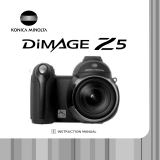8
T
ABLE OF CONTENTS
Image size (Movie) ...............................................................................................................................64
Frame rate ...............................................................................................................................64
Movie file sizes ........................................................................................................................64
Movie mode.............................................................................................................................65
A short guide to photography..............................................................................................................66
Advanced playback..............................................................................................................................68
Playing back movies ...............................................................................................................68
Capturing a movie frame.........................................................................................................69
Navigating the playback-mode menu .....................................................................................70
Frame-selection screen...........................................................................................................72
Delete ......................................................................................................................................73
Format .....................................................................................................................................74
Lock.........................................................................................................................................75
Copy and E-mail Copy............................................................................................................76
Slide Show ..............................................................................................................................80
About DPOF ............................................................................................................................82
DPOF setup.............................................................................................................................82
Date imprint.............................................................................................................................83
Index print ...............................................................................................................................83
Viewing images on a television ...............................................................................................84
Setup menu .........................................................................................................................................85
Opening the setup menu.........................................................................................................85
Navigating the setup menu .....................................................................................................86
LCD monitor brightness ..........................................................................................................88
Auto power save .....................................................................................................................88
Instant playback ......................................................................................................................89
Lens accessory .......................................................................................................................90
Language.................................................................................................................................90
File number (#) memory ..........................................................................................................91
Folder name ............................................................................................................................92
Date and time setup................................................................................................................93
Date imprinting ........................................................................................................................93
Reset default ...........................................................................................................................94
Audio signals ...........................................................................................................................95
Focus signal ............................................................................................................................96
Shutter FX................................................................................................................................96
Video output............................................................................................................................96
Transfer mode .........................................................................................................................96
Self-timer .................................................................................................................................96
9
Data-transfer mode..............................................................................................................................97
System requirements ..............................................................................................................97
Connecting the camera to a computer ...................................................................................98
Connecting to Windows 98 and 98SE ....................................................................................99
Automatic installation ......................................................................................................99
Manual installation.........................................................................................................100
Folder organization................................................................................................................102
Auto power save - data-transfer mode.................................................................................103
Disconnecting the camera ...................................................................................................104
Windows 98 and 98 Second Edition .............................................................................104
Windows Me, 2000 Professional, and XP .....................................................................104
Mac OS..........................................................................................................................105
Changing the memory card .................................................................................................106
Uninstalling the driver software - Windows ..........................................................................107
PictBridge..............................................................................................................................108
Notes on printing errors ........................................................................................................109
Navigating the PictBridge menu ...........................................................................................110
Appendix .......................................................................................................................................114
Troubleshooting.....................................................................................................................114
Care and storage...................................................................................................................116
Camera care ..................................................................................................................116
Storage ..........................................................................................................................116
Cleaning.........................................................................................................................116
LCD monitor care ..........................................................................................................117
Batteries.........................................................................................................................117
Operating temperatures and conditions........................................................................117
Memory cards................................................................................................................118
Before important events and journeys ..........................................................................119
Copyright .......................................................................................................................119
Questions and service ...................................................................................................119
QuickTime system requirements...........................................................................................120
Technical specifications ........................................................................................................122






















